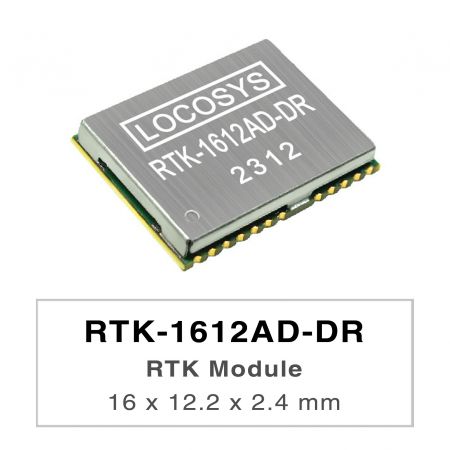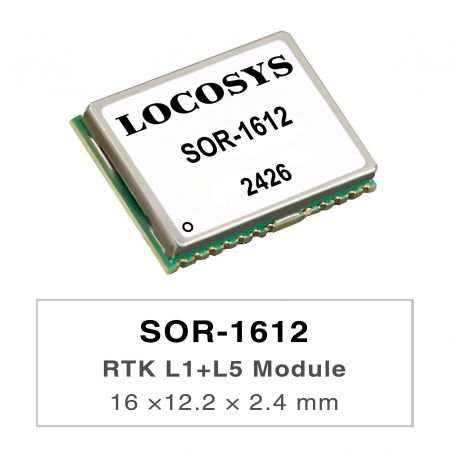-

RTK-1612AD-DR
RTK-1612AD-DR
LOCOSYS RTK-1612AD-DR uses an Airoha AG3335AD chip, dual-frequency multi-constellation solution GNSS, providing RTK high precision and sensor fusion solution in one. It not only supports GPS, GLONASS, GALILEO, BEIDOU, and QZSS but also has inertial sensors (3-axis accelerometers and 3-axis gyros) to provide an untethered dead reckoning function. In addition to DR, an inertial sensor can detect the vehicular dynamics when it is attached firmly on the vehicle. Consequently, abnormal driving behaviors and the vehicle status can be detected and the alarm status will be enabled to remind the users. No requirement of installation orientation and automatic calibration function make it easy to use. With these features, RTK-1612AD-DR can reduce position errors in multipath environment and continue to work where GNSS signals are poor or not available, such as tunnels and indoor parking lots, as well as deliver seamless navigation.
-

BKR-1612
BKR-1612
The BKR-1612 is a receiving module that supports Dual-Band & Multi-Mode. It has built-in highly integrated GNSS receiver chip, supports multi band and multi system cm4f (main frequency 350Mhz, 22nm Technology) chip of Third-generation BEIDOU Navigation Satellite System (BDS-3). Besides, it is capable of tracking all global civil navigation systems (GPS, GLONASS, GALILEO, BEIDOU, QZSS, IRNSS and SBAS) in all bands. BKR-1612 module is based on the state of art BDS-3 architecture, integrating multi-band and multi-system GNSS RF and baseband. This newly designed architecture makes this single chip achieve sub-meter level positioning accuracy without correction data from ground-based augmentation station and higher sensitivity, greater for improved jam resistance and multipath, provide a highly robust service in complicated environment. BKR-1612 module contains positioning engine inside, featuring high sensitivity, low power consumption, and fast TTFF. The superior cold start sensitivity allows it to acquire, track, and get position fix autonomously in difficult weak signal environment. The receiver’s superior tracking sensitivity allows continuous position coverage in nearly all outdoor application environments. The high-performance signal parameter searching engine is capable of testing 16 million time-frequency hypotheses per second, offering superior signal acquisition and TTFF speed.
-

SOR-1612
SOR-1612
LOCOSYS SOR-1612 is a high-performance dual-band GNSS RTK module that designed for applications requiring centimeter level positioning accuracy. The module supports concurrent reception of GPS, BeiDou, GALILEO and QZSS to improve the availability and reliability of RTK solution even in the harsh environment. The SOR-1612 module contains LOCOSYS dual-band RTK technologies that enables precise navigation and automation of moving machinery in industrial and consumer-grade products. It featuring high sensitivity, low power consumption, and fast TTFF in a compact surface-mounted form factor of 16.0 x 12.2 x 2.4 mm.
Press Release
-
 Taiwan Excellence Drone Alliance Visits LOCOSYS Technology, Focusing On Global Positioning Technology And Drone Applications
Taiwan Excellence Drone Alliance Visits LOCOSYS Technology, Focusing On Global Positioning Technology And Drone ApplicationsThe Taiwan Excellence Drone Overseas Business Alliance, led by Yen Tung-Piao,visited a leading smart manufacturing enterprise with a delegation includingrepresentatives from AIDC, the Industrial...
Read More -
 LOCOSYS Showcases Advanced Smart Positioning Technology At New Taipei Electric Vehicle Supply Chain Expo
LOCOSYS Showcases Advanced Smart Positioning Technology At New Taipei Electric Vehicle Supply Chain ExpoTo promote the development of Taiwan's electric vehicle (EV) industry and enhance international collaboration, the New Taipei City Government hosted the Electric Vehicle Supply Chain Expo...
Read More -
 LOCOSYS Technology Unveils New High-Performance SONY GNSS/RTK Global Satellite Positioning Modules
LOCOSYS Technology Unveils New High-Performance SONY GNSS/RTK Global Satellite Positioning ModulesLOCOSYS will showcase its advanced RTK solutions and high-performance GNSS modules, including those powered by Sony’s latest GPS technology, at the 2024 Sensor Expo in Tokyo. These modules,...
Read More
